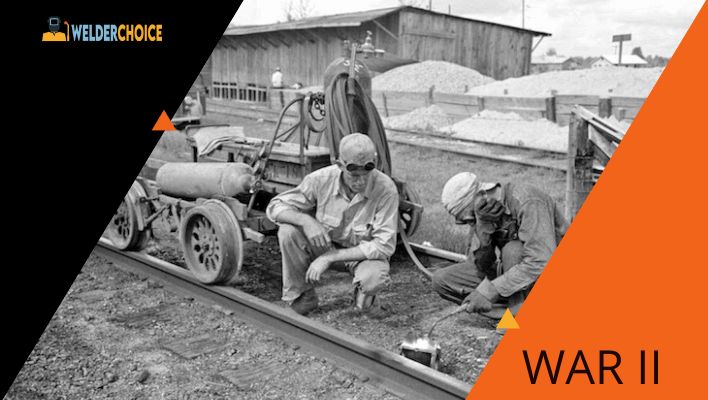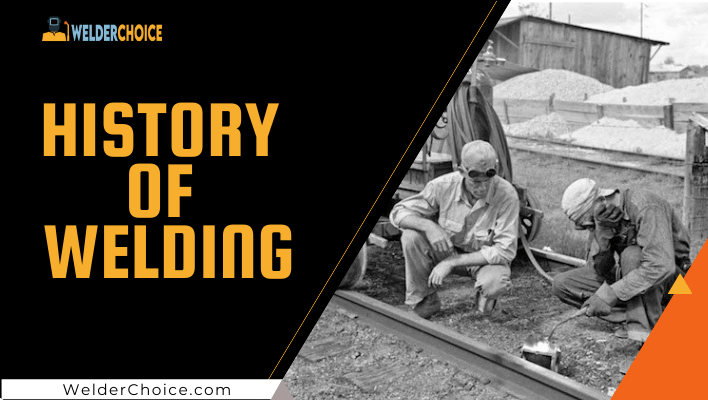Many processes can be used to combine two materials. as well as adhesives such as glues in this post we will discuss the history of welding in detail.
None of the aforementioned methods, on the other hand, are likely to work when connecting metal parts. For a more permanent bond, welding is the best solution.
An electric power source pumps gas into a welding torch or gun to create a high-heat flame during the welding operation.
To fuse the components together, a filler wire is introduced into the joint or seam, while the flame is fed directly to the base metal pieces to melt them at the edges. The welder moves the torch or gun down the junction to create a seam.
Many people believe welding was invented during the industrial revolution. Its origins, on the other hand, maybe traced back much further in welding history.
When Was Welding Invented?
Welding is thought to have been invented between 2,000 and 3,000 BC; the exact date is unknown, but this is the first indication of welding.
Who Invented Welding and When?
Egypt And China
The first known evidence of welding or metalworking can be found in ancient artifacts. The Incas and the ancient Egyptians both use rudimentary metal joining techniques.
The methods were primitive, consisting of hammering the metal pieces with large pebbles connected to hammers made of wood. The “hammer” just dented the metals together.
Soft metals such as gold, copper, bronze, and silver can be fashioned into jewelry, bowls, and cups. Heavier metals, such as iron, were utilized less frequently.

During the Bronze Age, between 2000 and 3000 BC, Egyptians discovered how to use charcoal to create fire and heat that could turn iron ore into solid metal iron.
By 1000 BC, they could make swords, spearheads, and large cooking pots. To melt metals for solder, the Egyptians built “furnaces.”
They then use a blowpipe to “blast” the solder into the metal joints, binding the metals together. In the tombs of the pharaohs, death masks, jewels, bowls, and other objects are painstakingly soldered.
The Sui Dynasty in China (5th-6th century BC) developed a technology for transforming wrought iron into steel, which they used to produce Samurai swords.
In The Middle Ages
By 1375, forge welding had been invented. Blacksmiths were probably the closest thing to a modern welder until the 18th century. The blacksmith used charcoal as fuel in a hand-hewn furnace.
The metals available at the time were full of defects and required extensive refining before they could be utilized for anything.
Blacksmiths would heat the iron and hammer out the faults on an anvil to improve its quality and resistance to separations or disintegration.
By repeatedly pounding the metal ends until they were the same thickness, the metal ends were “scarfed,” or tapered. The blacksmith may then “weld” the metal together with various degrees of heat.
He needed to produce white hot heat by boosting the charcoal and flame. He then connected the two pieces of metal together by lightly pounding the overlapped metal ends together while continually heating them.
The First Welding Patent
Auguste de Meritens and his student Nikolai Bernados conducted research in 1880 on harnessing the heat of an arc to unite lead metal plates for batteries.
The carbon arc welding process was later patented by them. Carbon arc welding became popular as a means of combining metals, particularly iron and lead, in the late 1800s and early 1900s.
The Origins of GTAW Welding
Since the 1800s, gas welding has been used. An English chemist named Edmund Davys was attempting to extract potassium metal when he found acetylene by accident.
When he heated potassium carbonate, a residue formed, which reacted with water to produce acetylene.
C.L. Coffin, an American inventor, invented the first arc welding process using a metal electrode in 1890.
The metal electrode melted the metal and moved it across the arc, where it was then deposited in the joint between two metal sheets to form a weld. This method of filler metal placement in a weld joint is still used today.
A Russian native named N. G. Slavianoff invented a similar method for moving metal along an arc, but he used it to make metal molds.
It took until the twentieth century for gas welding and cutting to be developed. In the year 1900, an acetylene torch was invented. In the 1920s, a major study in gas shielding in the arc and weld industry resulted in significant advances (such as plastic welding) (like plastic welding).
Alexander and Langmuir used two tungsten electrodes to release hydrogen from the arc and create a hotter flame when welding metal. In a similar experiment in 1926, H. M. Hobart and P.K. Devers employed argon and helium gas to supply the arc. This gave rise to the GMAW welding method.
In 1942, Meredith invented Heliarc welding, which is now known as gas tungsten arc welding (GTAW) or TIG welding.
The material to be welded is heated to the melting point with a tungsten electrode, resulting in a metal weld puddle. This is a more time-consuming and detailed welding process.
It employs an electric torch, and the welder must manually feed a filler rod into the molten pool. The heat pressure that feeds TIG welding’s welding properties can be controlled.
The TIG technique uses a non-consumable tungsten electrode to give energy to the welding arc.
During World War II, Welding Development
During World Wars I and II, welding saw the most significant advancements and innovations. During World War I, the demand for armaments and transportation prompted the establishment of new businesses that produced welding machines and electrodes.
Ship repair and construction necessitated the use of welding. Fuselages were required for the creation of larger airplanes capable of carrying explosives.

During World War II, arc welding became even more popular. The development of both weapons and heavy transporters fueled this growth.
The invention of the jet propulsion engine by the British revolutionized aerodynamics, allowing planes to travel faster and farther.
German advances in tank development gave birth to the “Panzers,” which were known for their impregnable armor and ability to cover difficult terrain.
Shipbuilding permanently switched from wood hulls to all-welded metal hulls in 1940. The first all-welded ship was the SS Exchequer, built by Ingalls Shipbuilding.
The cargo hull’s steel plates were welded end to end. Previously, riveting was used. The shipbuilding industry was transformed when a novel welding technology was introduced.
Liberty cargo ships were also mass-produced. US shipyards built 2,700 of these ships over the period of four years. There are more than 600,000 feet of welding joints involved.
Welding schools sprung up everywhere. Welding equipment was in high demand during WWII. Because of the advancement of automatic welding technology, subcontracted companies were able to produce massive quantities of gun carriages, machine guns, and ammunition cases.
Meredith, a Northrop Aircraft employee, invented GTAW to weld magnesium and stainless steel. In the construction of fighter jets, the GTAW process was crucial. General Electric invented automatic welding technology for welding magnesium and other high-strength light alloys in 1943.
Start of MIG Welding
This prompted the usage of aluminum in airplane construction. Manufacturers sought lighter metals in order to increase the aerodynamic properties of their airplanes.
As a result, they’d be able to fly higher and quicker. To speed up the manufacturing process, companies and scientists explored welding procedures that could fuse aluminum and other non-ferrous materials.
The gas tungsten approach could not be used because of the expensive cost of inert gases and the limited flexibility of position welding.
Battelle Memorial Institute invented a gas shielded metal arc welding technique, sometimes known as GMAW or MIG welding, in 1948.
Compared to traditional welding, this method allowed for faster wire-fed metal deposition into weld joints. The approach also allowed the welder to work in a number of positions, such as horizontally and overhead.
In GMAW, a wire welding electrode on a spool is automatically fed onto the two weld piece ends. An arc created by an electrical current between the metal and the wire, which is shielded by a shielding gas, heats the wire to melting point.
In the 1950s, GMAW was first used in the automotive manufacturing process, and it has since evolved into the industry’s primary welding method.
Recent Advances in Welding
Following the war, enterprises restarted consumer and industrial goods manufacturing.
Because of its tensile strength and corrosion resistance, steel became increasingly popular in the 1950s and 1960s for the construction of buildings, bridges, and other structures. GTAW became prohibitive in major construction projects due to the high cost of natural gas.
In 1953, carbon dioxide was initially used instead of inert argon and helium gases, making GMAW more cost-effective. A shorter arc for use in the GMAW technique was created in 1958, allowing GMAW to weld thinner materials.
GMAW became a very versatile and widely used technology as a result of these developments, and it became the favored approach for industrial applications.
As industrial processes became more automated – first on the assembly line, then in robotic automated operations – GMAW proved to be a more adaptable welding procedure than any other. GMAW is now the most extensively used process in industry.
Russia started investigating welding technologies that may be used more easily in high-speed automated processes in 1956.
Friction welding is a non-melting method of joining solid materials by creating mechanical friction as two work components are heated.
It’s a very precise method that can operate at high speeds while being cost-effective. It comes in handy while welding incompatible materials.
During friction welding, heat must be properly controlled since too high a temperature across the weld joint can induce excessive stress in the linked pieces, resulting in brittleness and breakage.
Friction welding, on the other hand, is dependable and, when correctly controlled, may produce high-quality welds.
Welding procedures have become more precise and speedier in the twenty-first century. Manufacturers and industrialists are still on the lookout for methods to produce high-speed, consistent, high-quality welds. The goal is to create welding procedures that are more efficient and require fewer passes.
Experiments with the laser beam led to the development of laser welding in the 1960s. Less inert gases are required for laser welding.
The higher temperatures resulted in three benefits: faster weld formation, reduced cracking, and firmer, tougher weld joints.
Laser beam welding is useful for piercing tight, deep metal connections. It’s used in robotic automobile and industrial manufacturing.
Despite its numerous advantages, laser beam welding has yet to gain widespread adoption due to high equipment costs, the impossibility to transport equipment from one location to another, limited welding positions, and high operational costs.
Conclusion
Since its inception in ancient Egypt, welding has been the primary method for attaching two pieces of metal or metal and different materials together to make a strong connection that will not allow the two elements to split.
Welding is now used in almost all industries that use metal goods.

With 8 years of experience a senior welding instructor and safety equipment researcher and writes articles, reviews and guidelines on helmets and other welding and safety gears at Welder Choice, and other written works have been published in various publications.
